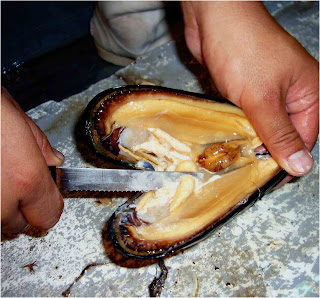Mussel larvae production for Pacific beakfish larvae (Oplegnathus insignis)
Mussel larvae
production for Pacific beakfish larvae (Oplegnathus insignis)
Masatoshi FUTAGAWA*¹
Septiembre 17, 2012
*¹ Corporación Privada para
el Desarrollo de la Universidad Arturo Prat, CORDUNAP, Iquique, Chile
Mussel larva shows 50 mm approximately and
swims freely. The size is ideal for primary live feeds for O. insignis larva. Mussel larvae are fed at density 50 larvae/ml
with 6 hours interval from Day 3 to 10. Additionally, the larva has advantages
of well nutrition and easy production. This method produces 30 million mussel
larvae from a female at 30 hours after fertilization. The larvae survive until
D2 and eggs settle on larva tank within 6 hours approximately.
1.
Mussel
gonad shows that male has cream color and female has coffee color.
2.
Insert knife below the hinge, cut ligament and
open shells. Press male gonad to release sperm and keep in bucket (A) with 10 L
of sea water.
3.
Opened shells are kept in bucket (B) with 10 L
of sea water in order to collect drip-out gonad.
4.
Take out female from the bucket (B), scrape
gonad and gather in strainer. Removed shells are kept in another bucket (C) with
10 L of sea water. Then removed gonads are homogenized by hand mixer.
5.
Homogenized gonads mix in the bucket (B) and kept
in incubator (80 L conical tank). Also eggs in bucket (C) kept incubator with 30
L of water through 1 m/m of strainer. One half sperm water in bucket (A) adds to
incubator and fills up water to 80 L. Then wait 20 minutes with strong aeration
to induce fertilization.
6.
Stop aeration and wait 15 minutes to separate
floating sperm and fertilized egg which settle on bottom. Remove water from the
surface by siphon three times, 30 L, 30 L and 40 L with 15 minutes interval accordingly.
Fertilized egg incubate 30 hours with gentle aeration
7.
Hook 1 ml in incubator and fill up 10 ml, sample
larvae number multiply 10 and water volume.
v















Comments
Post a Comment